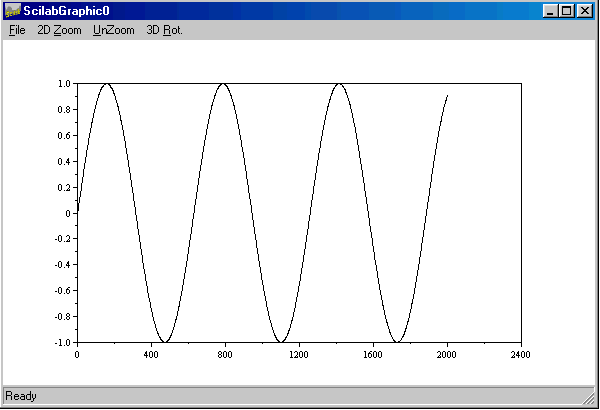zeros All zeros
ones All ones
rand Random elements (either normal or uniform)
Working with Matrices
This section introduces you to other ways of creating matrices. The SCILAB is most powerful while handling matrices it allows you to manipulate the matrix as a whole.
Generating Matrices
SCILAB provides three functions that generate basic matrices:
|
zeros All zeros |
|
|
ones All ones |
|
|
rand Random elements (either normal or uniform) |
Some examples
zeros(3,3)
ans =
! 0. 0. 0. !
! 0. 0. 0. !
! 0. 0. 0. !
4*ones(3,3)
ans =
! 4. 4. 4. !
! 4. 4. 4. !
! 4. 4. 4. !
rand(4,4,'normal')
ans =
! 1.4739763 .2546697 - 1.0327357 .0698768
!
! .8529775 - .6834217 - .9239258 - 1.3772844
!
! .7223316 .8145126 2.7266682
- .1728369 !
! .6380837 - .1884803 - 1.7086773 - .6019869
!
Load
Theload command reads binary files
containing matrices generated by earlier SCILAB sessions, or reads text files
containing numeric data. The text file should be organized as a rectangular
table of numbers, separated by blanks, with one row per line, and an equal
number of elements in each row. For example, outside of SCILAB, create a text
file containing these four lines:
magic_square.dat.
save magic_square
Then the command
load magic_square.datReads the file and creates a variable,
magic,
containing our example matrix.
SCI-Files
You
can create your own matrices using sci-files, which are text files
containing SCILAB code. Just create a file containing the same statements you
would type at the LAB command line. Save the file under a name that ends in .sci.
Note:
To write a sci-file open a textpad or notepad
and write the code in the text file. Then save the file with the extension <filename.sci>.
On the command window go the file control button and click the exec
option and choose the file you want to execute.
For
example,
A
sci-file which will plot a sine wave, (use notepad to write the code)
//
this is comment line
//
sci-file to plot sine wave
time
= 0:.01:20;
plot(sin(time));
save
this file as My_prog.sci and run the program as
mentioned above. You can also run the program in command window by typing,
exec('Pathname')
i.e.,
exec('E:\Scilab-2.6\work\My_prog.sci')
On executing the program you will see the Sine wave in the figure window as show below.

Concatenation
Concatenation
is the process of joining small matrices to make bigger ones. In fact, you made
your first matrix by concatenating its individual elements. The pair of square
brackets, [], is the concatenation operator.
For example,
a = [ 1 2 3 ]; b= [ 4 5 6]; c = [ 7 8 9];
d= [ a b c]
d =
! 1. 2. 3. 4. 5. 6. 7. 8. 9. !
Deleting Rows and Columns
You can delete rows or columns from a matrix by using just a pair of square brackets.
For example,
s = [ 1 2 3 4; 5 6 7 8; 9 10 11 12 ]
s =
! 1. 2. 3. 4.
!
! 5. 6. 7. 8.
!
! 9. 10. 11. 12. !
s(:,2) =[]
produces
s =
! 1. 3. 4. !
! 5. 7. 8. !
! 9. 11. 12. !
If you delete a single element from a matrix, the result isn't a matrix anymore.
So if you type expressions like ,
s(1,3) =[]
!--error 15
submatrix incorrectly defined
will result in error.
However, using a single subscript deletes a single element, or sequence of elements, and reshapes the remaining elements into a column vector. So,s(2:2:9) = [ ]
results in
s = ! 1. ! ! 9. ! ! 6. ! ! 3. ! ! 11. ! ! 4. ! ! 8. ! ! 12. !